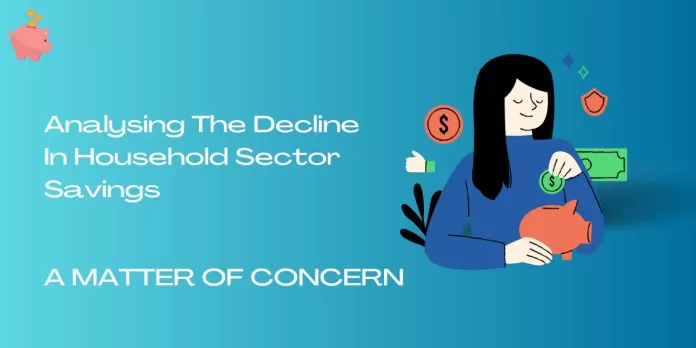The state of a nation’s economy is deeply intertwined with the financial health of its households. Household savings play a crucial role in economic stability and growth. Recent data indicates a significant decline in the savings of the household sector in terms of financial assets as a percentage of GDP, raising concerns about its implications.
In this blog, we’ll delve into the numbers and analyse the potential reasons behind this decline, as well as its potential impact.
Understanding the Data
The household sector’s financial savings as a percentage of GDP stood at 5.1% in 2022-23, a sharp drop from the relatively stable range of 7% to 8% seen from 2011-12 to 2019-20. Notably, in the midst of the COVID-19 pandemic in 2020-21, the savings briefly spiked to 11.3%, but it was a singular exception. The decline continued into 2021-22, with savings at 8.3% of GDP. The question now arises: should we be concerned about this sharp fall in 2022-23?
Factors Contributing to the Decline
To understand the decline, we need to consider changes in household financial assets and liabilities. When compared to the pre-COVID five-year average from 2015-16 to 2019-20, the 5.1% figure is lower by 2.7 percentage points. This decline is composed of a 2.2%-point increase in gross household financial liabilities and a 0.5%-point decrease in gross household financial assets over the corresponding periods.
Read: Indian Banking System – Liquidity Deficit
One significant factor contributing to this fall is the substantial rise in bank advances, including personal loans, in 2022-23 compared to pre-COVID years. Bank advances as a percentage of GDP increased from 2.5% in 2019-20 to 4.5% in 2022-23. Data from the Reserve Bank of India (RBI) suggests an average growth of 19.5% in outstanding bank advances for the household sector from April to July 2023, indicating a persistent trend.
Net vs. Gross Financial Assets
It’s also essential to consider whether we should assess the household sector’s financial health based on net financial assets or gross financial assets. While the net financial assets rate has decreased primarily due to a rise in financial liabilities, gross financial assets as a percentage of GDP have remained relatively stable at 10.8% in 2021-22 and 10.9% in 2022-23.
Implications for the Economy
The decline in the net financial assets rate has broader implications. A more optimistic interpretation of the rise in the household sector’s borrowings is that it reflects a buoyant sector willing to invest. However, the fact remains that the net financial savings ratio of the sector has fallen. This affects the government’s and corporate sectors’ borrowing capacity.
For instance, the acceptable fiscal deficit for both the Central and State governments combined is based on the assumption that household savings will be around 7% of GDP, with an additional 2.5% from abroad. If household savings remain at 5% of GDP, this could stress government budgets, potentially requiring lower fiscal deficits.
The Way Forward
To address this issue, it’s crucial to ensure that gross financial assets of the household sector increase, even if financial liabilities rise. While gross financial assets have fallen slightly, this trend should be reversed to maintain the household sector’s financial savings rate.
Conclusion
In conclusion, the sharp decline in the household sector’s savings in financial assets is a matter of concern. It not only impacts individual households but also has wider economic implications. As we analyse this data, it’s essential to consider both net and gross financial assets and explore potential strategies to reverse this trend. Whether this decline is a one-off occurrence, or a persistent trend remains to be seen, but it underscores the need for continued vigilance and prudent financial management at both the individual and policy levels.
Disclaimer: This blog has been written exclusively for educational purposes. The securities mentioned are only examples and not recommendations. It is based on several secondary sources on the internet and is subject to changes. Please consult an expert before making related decisions.


